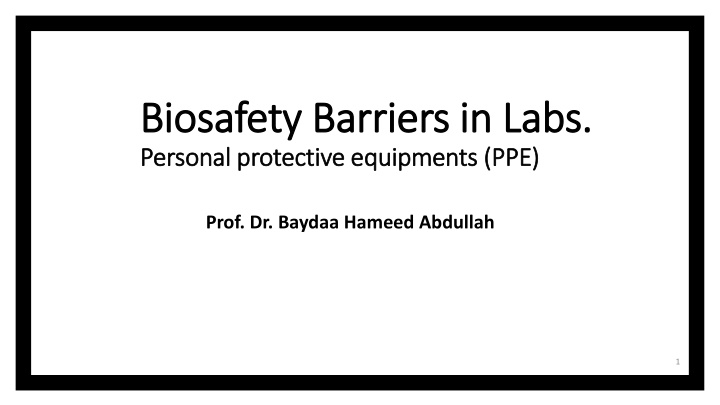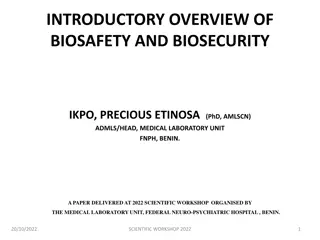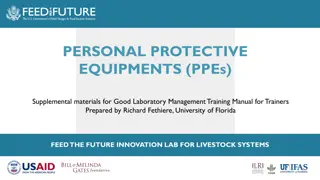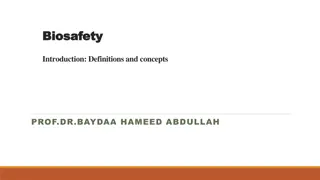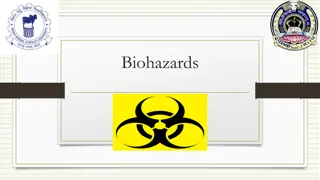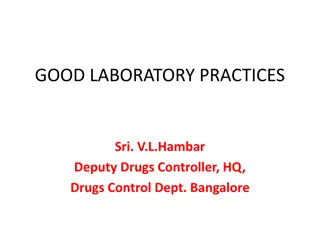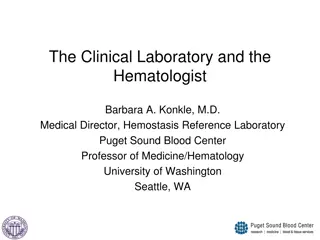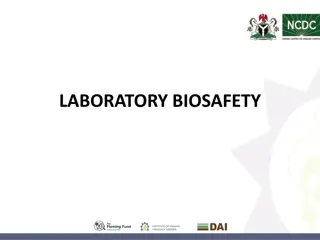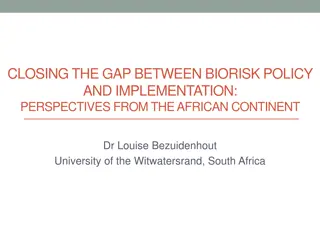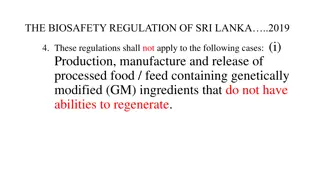Ensuring Biosafety in Laboratory Settings: Barriers and Practices
Biosafety in laboratories involves implementing various barriers and practices to prevent the release of biological agents and protect lab workers. These include primary and secondary barriers, personal protective equipment (PPE), containment principles, and adherence to biosafety practices. Safety equipment such as biological safety cabinets play a crucial role in minimizing exposure to hazards. Understanding the principles of biosafety and following strict microbiological practices are essential for maintaining a safe working environment.
Download Presentation

Please find below an Image/Link to download the presentation.
The content on the website is provided AS IS for your information and personal use only. It may not be sold, licensed, or shared on other websites without obtaining consent from the author.If you encounter any issues during the download, it is possible that the publisher has removed the file from their server.
You are allowed to download the files provided on this website for personal or commercial use, subject to the condition that they are used lawfully. All files are the property of their respective owners.
The content on the website is provided AS IS for your information and personal use only. It may not be sold, licensed, or shared on other websites without obtaining consent from the author.
E N D
Presentation Transcript
Biosafety Barriers in Labs. Biosafety Barriers in Labs. Personal protective Personal protective equipments equipments (PPE) (PPE) Prof. Dr. Baydaa Hameed Abdullah 1
Containment The principle of holding or be capable of holding or including within a fixed limit or area Biocontainment: preventing the release of biological agents 2
Primary and Secondary Barriers PRIMARY BARRIERS (control hazard at source) BSC HEPA filter(high efficiency particulate air) BSC SECONDARY BARRIERS (structure surrounding primary barrier) Sealed perimeter ,Exhaust HEPA filters 3
Primary barriers Physical barriers or personal protective equipments (PPE) for lab worker Gloves, masks, Goggles, aprons, suits, special breathing apparatuses Primary containment equipment BSC Sealed centrifuge 4
Secondary Barriers Secondary barriers: structural aspects of the laboratory that make working environment safer against infection such as Sinks for hand washing, Special containment areas, Special air ventilation patterns and Sterilization equipments. HEPA filters Liquid effluent treatment Sealed laboratory walls and floors 5
Principles of Biosafety Practice and procedures Standard practices Special practices and considerations Safety equipment Facility design and construction Increasing levels of protection 6
1 Standard Microbiological practices Most important concept / strict adherence Aware of potential hazard Trained and proficient in techniques 7
2 Safety Equipment Primary containment barrier Minimize exposure to hazard Engineering controls / equipment PPE Biological safety cabinets 8
Safety equipment includes biological safety equipment, enclosed containers, safety centrifuge cups, and other engineered controls designed to minimize exposure to biological agents. Biological safety cabinets are among the most important safety equipment for protection of personnel and the laboratory environment, and most also provide product protection. Safety equipment is most effective at minimizing exposure when workers are trained on the proper use of such equipment and the equipment is regularly inspected and maintained. 9
PPE Specialized clothing/equipment worn by an employee for protection against infectious materials (OSHA) Provides protection from (bio)hazards It is removable and/or disposable (prevents contamination of community and environment) Must be worn when handling hazards (including infectious materials) Must be removed before leaving the work place
PPE SELECTION Is made based on risk assessment Factors that influence PPE selection: Routes of transmission Types of anticipated exposure(s) Available engineering controls Durability/appropriateness for task(s) Limitations Fit Donning/Doffing
PPE SELECTION Is made based on risk assessment Factors that influence PPE selection: Routes of transmission direct contact droplets aerosols Types of anticipated exposure(s) Available engineering controls Durability/appropriateness for task(s) Limitations Fit o o o
PPE SELECTION Is made based on risk assessment Factors that influence PPE selection: Routes of transmission Types of anticipated exposure(s) skin? mucous membranes respiratory tract gastrointestinal tract Available engineering controls Durability/appropriateness for task(s) Limitations o o o o
PPE SELECTION Is made based on risk assessment Factors that influence PPE selection: Routes of transmission Types of anticipated exposure(s) Available engineering controls Durability/appropriateness for task(s) must be appropriate for intended use Limitations many different types and materials Fit should be as comfortable as possible Donning/Doffing o o o
Prevents spread of contamination to street clothes/exposed skin Body protection dependent on containment level, hazards (biological, chemical, etc.), and procedures: TYPES OF PPE Body protection Flame resistant/retardant o Fluid resistant/repellant o Disposable o Solid front o Cuffed sleeves o Positive-pressure suits o
TYPES OF PPE Body protection Head Protection: Protect hair and scalp from contamination Hair covers Foot Protection: Protect entire foot Disposable shoe covers (additional layer ofprotection) o Rubber boots o Dedicated lab shoes o Non-slip footwear Additional Body Protection (based on risk assessment): Disposable sleeve covers Scrubs o o o o o o
PPE Lab Coats and gowns used to protect from infectious fluids Don t wear lab coats outside of the lab or take them home Cuffed sleeves can protect the wrists and lower arms 17
BODY PROTECTION Gown/lab coat1,2 Use3 Disposal Re-Use Barrier between a user s body and the agent, minimizing exposures to splashes, spills, and fomites If single-use PPE is utilized, dispose after use in appropriate container for medical or biohazard waste Single-use PPE should NOT be cleaned and reused, but gowns do not need to be changed between same- diagnosis patients unless contaminated Reusable PPE should be collected by the facility, decontaminated, then laundered on site or via a specialty company (NOT at the user shome)4 Gowns recommended for healthcare workers (aprons acceptable if gowns unavailable) Lab coats recommended for diagnosticians Adapted from Sandia National Laboratories
TYPES OF PPE Face protection Worn when potential risk for splashing/splattering Prevents splashing of infectious materials into eyes, nose, and/or mouth Protects mucous membranes from exposure Examples: Face shield Surgical mask o Indirectly vented safety goggles o Safety glasses o o
PPE Eye and Face Protection protect mucous membranes and prevent ingestion whenever there is potential for splash to eyes/face 20
FACE PROTECTION Face shield/goggles Use Disposal Re-Use Barrier between a user s face and the agent when there is a splash risk to the eyes2 Full face- shields recommended for healthcare workers Goggles recommended for diagnosticians, researchers At the end of the product s life (broken, torn, no longer functional, etc.), facial PPE is disposed of as solid medical or biohazard waste Face shields and goggles are designed to be cleaned and reused Clean using appropriate chemical disinfectants3 Some facial PPE can be sterilized by steam autoclave
TYPES OF PPE Hand protection Reduces potential of hand contamination Reduces risks associated with ingestion and skin contact Gloves are made of different materials o Latex, nitrile, vinyl, polyethylene, etc. Should be selected for specific activity and hazard Suitability of glove needs to be verified prior to handling infectious materials
HAND PROTECTION Gloves Use Disposal Re-Use Barrier between a user s hands and the agent, minimizing surface contamination Ideally, one-time use, powder-free After use, gloves should be disposed in the appropriate container for solid medical or biohazard waste Solid waste should be autoclaved according to local (and/or other) regulations Alternatively, solid waste may be incinerated Designed to be disposed after use It is NOT recommended that they be washed and reused Nitrile recommended2 Vinyl and latex can be used as alternatives Adapted from Sandia National Laboratories
PPE Gloves Wear disposable vinyl, synthetic or N-DEX nitrile gloves when working with biohazardous materials 24
PPE Gloves Avoid latex gloves (may cause allergies) Do not reuse gloves Do not wear gloves outside of the laboratory Wash hands after removing gloves 25
PPE Respiratory Protection Two types: air supplying and air purifying Full face, half face, PAPR (Powered Air Purifying Respirator) Special considerations: fit testing; facial hair; comfort; care and maintenance 26
TYPES OF PPE Respiratory protection Removal of contaminants from the air by filtration of: particulates chemicals gases Respirators divided into two classes: air-purifying negative pressure vs. positive pressure atmosphere-supplying
RESPIRATORY PROTECTION Air-purifying respirators Draw contaminated air through a filter or chemical cartridge Non-powered and powered respirators Negative pressure vs. positive pressure 3 different filter efficiency levels 95% 99% o 100% (99.97%) N vs. R vs. P N for Not resistant to oil R for Resistant to oil P for oil Proof o o
PPE Respiratory Protection N95 respirators N100 respirators 29
RESPIRATORY PROTECTION Air-purifying respirators Respirators must fit well with proper seal to provide adequate protection Fit tightly against the face and form a seal between edge of respirator and face of wearer Fit testing must be done: o Prior to use o Whenever different make, model, or size of respirator is used o Changes in facial structure o Annually Fit testing can be quantitative or qualitative
Powered Air-Purifying Respirators (PAPRs): Comfortable for continuous wear No fit testing required Under positive pressure RESPIRATORY PROTECTION Air-purifying respirators o o o
RESPIRATORY PROTECTION Air-purifying respirators Atmosphere-supplying respirators use clean, breathable air from gas cylinder or air compressor Operate under positive pressure Examples: Self-Contained BreathingApparatus (SCBA) Air-line (supplied air respirators) o Supplied air suit (positive pressure suit) o o
PPE should be carefully inspected for damages/breaches prior to donning PPE Change gloves as needed Gloves become means of spreading infectious materials when contaminated Doffing PPE must be performed carefully to minimize contamination Doffing PPE needs to be immediately followed by handwashing Proper disposal of PPE as biohazard waste Proper decontamination and laundering of reusablePPE PPE Proper use/removal
BIOSAFETY CABINETS (BSC) BSCs provide effective primary containment for work with infectious material or toxins when they are properly maintained and used in conjunction with good laboratory techniques 34
BIOSAFETY CABINETS (BSC) Fume Hood Laminar Flow Cabinet (LFC) Biohazard Safety Cabinet (BSC) 35
Facility Design The design of a facility is important in providing a barrier to protect people working inside and outside the laboratory, as well as to protect people in the community from infectious agents that may be accidentally released from the laboratory. The recommended secondary barrier(s) will depend on the risk of transmission of specific agents. For example, the exposure risks for most laboratory work in BSL-1 and BSL-2 facilities will be direct contact with the agents through contaminated work environments.Secondary barriers in these laboratories may include separation of the laboratory work area from public access; availability of decontamination equipment (e.g., autoclave*); and handwashing facilities. In BSL-3 facilities, additional safeguards, such as directional airflow airlock- controlled entry and exiting, a shower used for personnel to shower out may be required. 39
Facility Design As the risk for aerosol transmission increases, higher levels of primary containment and multiple secondary barriers may become necessary to prevent infectious agents from escaping into the environment. Such design features could include *specialized ventilation systems to ensure directional airflow *air treatment systems to decontaminate or remove agents from exhaust air *controlled access zones *an airlock at the laboratory entrance * separate buildings or modules for physical isolation of the laboratory building itself. 40
Thank you 41
